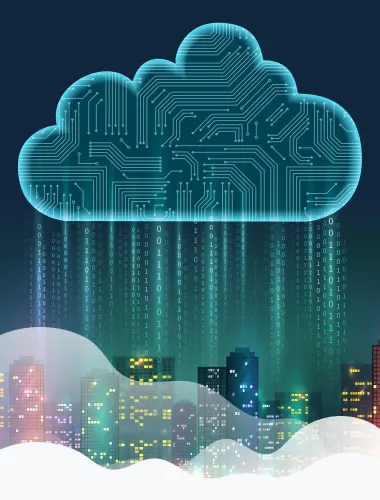Articles
Revolutionising Connectivity: IXPs and Their Impact on India’s Tier-2 Cities
When you hear the word “hub”, what comes to mind? A busy airport, perhaps? Or maybe a bustling marketplace? Well, for India’s Tier-2 cities, a new kind of hub is emerging– Internet Exchange Points, or IXPs for short.
With 751.5M internet users in January 2024 and 398.35M rural subscribers by March, improved infrastructure has reduced latency, boosted startups, and attracted businesses to Tier-2 cities, fostering economic and digital transformation.
What are IXPs?
IXPs are physical locations where multiple networks come together to interconnect and exchange internet traffic. Think of them as the glue that holds the internet together. Without them, your favorite binge-watching sessions and social media scrolling would not be possible.
The Benefits of IXPs
So, what’s the big deal about IXPs, you ask? Well, let me break it down for you:
Reduced Latency
Latency is a technical term for the time it takes for data to travel from one point to another. And let’s face it, no one likes waiting for a webpage to load. With IXPs, data no longer has to travel long distances to reach its destination, resulting in lightning-fast internet speed.
Enhanced Internet Speed
IXPs play a crucial role in alleviating network congestion, resulting in a faster and smoother online experience. With reduced buffering and enhanced streaming capabilities, users can enjoy uninterrupted access to their favorite content.
Lower Data Transfer Costs
With IXPs, Internet Service Providers (ISPs) eliminate the need to rely on third-party networks for data transfer, significantly reducing operational costs. These savings are often passed on to customers, making internet services more affordable and accessible, while enabling ISPs to enhance their competitive edge.
The Impact on Tier-2 Cities
Imagine you live in a Tier-2 city and you want to access a website that is based in the same city. Without an IXP, your data would have to travel to a larger city, such as Mumbai or Delhi, before reaching its destination. This not only slows down your internet speed but also increases costs for your ISP, which are then passed on to you, the customer.
But with an IXP in your city, your data can be exchanged locally, resulting in faster internet speeds and lower costs for you. Plus, with more efficient local traffic exchange, Tier-2 cities can attract more businesses and investments, leading to a boost in their digital infrastructure and overall development.
1. Enhanced Connectivity:
IXPs in Tier 2 cities enable local data exchanges, significantly reducing the distance data must travel. This results in lower latency, improved reliability, and faster internet speeds for both users and businesses. By routing traffic locally, IXPs eliminate the need to depend on external or metro-level exchanges, ensuring seamless connectivity for regional ISPs. This enhanced connectivity supports smoother online experiences for activities like video streaming, and gaming. Moreover, businesses in Tier 2 cities benefit from improved performance for cloud-based applications and communication tools, making IXPs a cornerstone for local internet ecosystem enhancement.
2. Boosted Local Economy:
The establishment of IXPs often acts as a magnet for tech companies, startups, and data centers to set up operations in Tier 2 cities. This influx of businesses not only diversifies the regional economy but also creates employment opportunities in technology, logistics, and allied sectors. Improved connectivity encourages entrepreneurship by reducing barriers to entry for digital businesses. Over time, this contributes to increased investments, urban development, and enhanced living standards. By fostering a conducive environment for digital business growth, IXPs play a pivotal role in driving sustainable economic development in Tier 2 cities.
3. Improved Content Accessibility:
With IXPs, content delivery becomes faster and more efficient, as popular services like streaming platforms, social media, and gaming servers can cache data locally. This ensures that end-users experience minimal buffering, quick load times, and seamless access to their favorite online platforms. For businesses, the benefits extend to better access to global services such as cloud computing and SaaS applications. This improvement in content accessibility creates a more inclusive digital environment, ensuring that users in Tier 2 cities can enjoy the same quality of internet services as those in metropolitan areas.
4. Cost Efficiency:
By facilitating local data exchanges, IXPs reduce the need for data to traverse long distances via upstream providers, cutting transit costs for ISPs. These cost savings can be passed on to consumers, making internet services more affordable and accessible. For businesses, reduced operational costs translate into better profit margins and the ability to offer competitive pricing for digital products and services. Additionally, lower bandwidth expenses enable smaller ISPs to thrive, fostering a diverse and competitive internet service market in Tier 2 cities.
Businesses also benefit from reduced operational expenses, which enhance profit margins and enable competitive pricing for digital services. From my experience, ISPs have seen a notable reduction in internet distribution costs. This trend extends beyond India to SAARC countries, where German-based Indian Interconnection platform have acted as catalysts in lowering transport costs and enhancing the value of peering.
5. Support for Digital Transformation:
IXPs provide the robust infrastructure needed to support digital tools, cloud services, and online platforms essential for digital transformation. Businesses in Tier 2 cities can leverage this improved connectivity to adopt advanced technologies like IoT, AI, and big data. Educational institutions can expand their reach through online learning platforms, while government bodies can enhance public service delivery through e-governance initiatives. By enabling access to modern technologies, IXPs accelerate digital adoption across sectors, positioning Tier 2 cities as active participants in the digital economy.
By fostering a rich peering environment, IXPs support the growth of digital ecosystems where content providers, cloud services, and enterprises can interconnect directly. This interconnectivity is crucial for the digital transformation of businesses and public services.
6. Empowerment of Rural and Semi-Urban Areas:
Tier 2 cities often serve as connectivity hubs for nearby rural and semi-urban regions. By hosting IXPs, these cities can extend the benefits of enhanced connectivity to underrepresented areas. This expanded reach promotes digital inclusion, giving rural populations better access to education, healthcare, financial services, and entertainment. It also helps bridge the digital divide, enabling equal opportunities for individuals and businesses in remote regions to thrive in the digital age.
The Future of Connectivity in India
The growth of IXPs in Tier-2 cities is just the beginning of a larger digital transformation in India. Internet User Growth estimates suggest that by 2025, India will have around 900 million Internet users, with 56% of new users emerging from rural areas. India’s digital economy has the potential to create up to $1 trillion in economic value by 2025, empowering millions across both rural and urban areas.
As more and more people gain access to the internet, the demand for faster and more affordable connectivity will only continue to rise. And with IXPs at the forefront, India is well on its way to
becoming a digitally advanced nation.
Government programs and increased investments will further enhance infrastructure and digital literacy, supporting a thriving digital ecosystem
BharatNet is one of the world’s largest rural broadband projects, aimed at connecting all Gram Panchayats (local governing bodies) in India—around 2.5 lakh—to high-speed internet.
Launched in 2011, the project ensures equal access to broadband for service providers like ISPs, mobile operators, and cable TV providers. Its goal is to enable e-health, e-education, and e-governance services in rural and remote areas.
By October 2024, BharatNet has connected 2.14 lakh Gram Panchayats, laid 6.92 lakh kilometers of fiber optic cables, provided over 11.69 lakh Fiber-To-The-Home (FTTH) connections, and installed 1.04 lakh Wi-Fi hotspots for last-mile connectivity.
The BharatNet project aims to connect over 630,000 inhabited villages with high-speed internet. Upon completion, it is expected to significantly reduce the digital divide between urban and rural regions.
In Conclusion
IXPs may not be as glamorous as airports or marketplaces, but they are undoubtedly the driving force behind the digital revolution in India’s Tier-2 cities. By reducing latency, enhancing internet speed, and lowering data transfer costs, they are paving the way for a more connected and developed nation. So, the next time you’re binge-watching your favorite show or scrolling through Instagram, remember to thank the IXPs for making it all possible.
Subscribe to Newsletter

